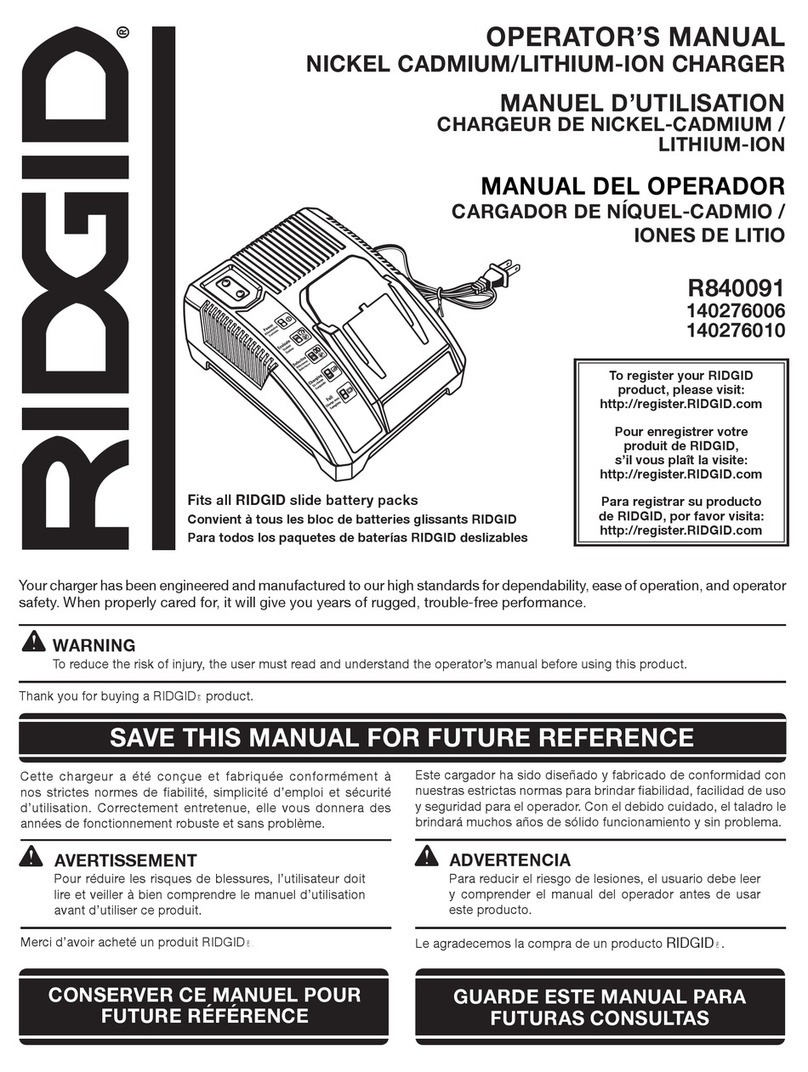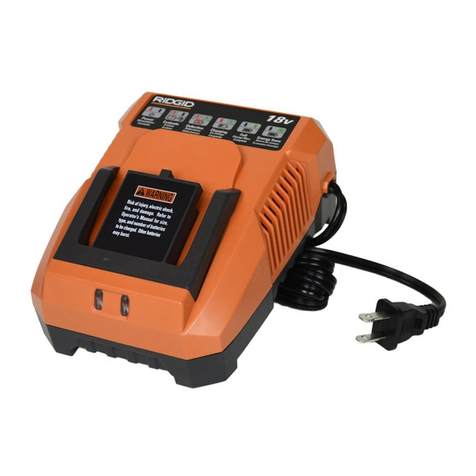RIDGID 140276002 User manual

1
Your dual port charger has been engineered and manufactured to our high standards for dependability, ease of operation,
and operator safety. When properly cared for, it will give you years of rugged, trouble-free performance.
WARNING:
To reduce the risk of injury, the user must read and understand the operator’s manual before using this product.
Thank you for buying a RIDGID product.
SAVE THIS MANUAL FOR FUTURE REFERENCE
OPERATOR’S MANUAL
DUAL PORT BATTERY CHARGER
Model No. 140276002
??
Fits all RIDGID
slide battery packs

2
3
IMPORTANT SAFETY INSTRUCTIONS
SAVE THESE INSTRUCTIONS
WARNING!
READ AND UNDERSTAND ALL INSTRUCTIONS.
Failure to follow all instructions listed below, may
result in electric shock, fire and/or serious personal
injury.
n Before using battery charger, read all instructions and
cautionary markings in this manual, on battery charger,
battery, and product using battery to prevent misuse of
the products and possible injury or damage.
CAUTION:
To reduce the risk of electric shock or damage
to the charger and battery, charge only nickel-
cadmium rechargeable batteries as specifically
designated on your charger. Other types of
batteries may burst, causing personal injury or
damage.
n Do not use charger outdoors or expose to wet or damp
conditions. Water entering charger will increase the risk
of electric shock.
n Use of an attachment not recommended or sold by the
battery charger manufacturer may result in a risk of
fire, electric shock, or injury to persons. Following this
rule will reduce the risk of electric shock, fire, or serious
personal injury.
n Do not abuse cord or charger. Never use the cord to
carry the charger. Do not pull the charger cord rather than
the plug when disconnecting from receptacle. Damage
to the cord or charger could occur and create an electric
shock hazard. Replace damaged cords immediately.
n Make sure cord is located so that it will not be stepped
on, tripped over, come in contact with sharp edges or
moving parts, or otherwise subjected to damage or
stress. This will reduce the risk of accidental falls, which
could cause injury, and damage to the cord, which could
result in electric shock.
n Keep cord and charger from heat to prevent damage
to housing or internal parts.
n Do not let gasoline, oils, petroleum-based products,
etc., come in contact with plastic parts. They contain
chemicals that can damage, weaken, or destroy plas-
tic.
n Do not operate charger with a damaged cord or
plug, which could cause shorting and electric shock. If
damaged, have the charger replaced by an authorized
serviceman.
n Do not operate charger if it has received a sharp blow,
been dropped, or otherwise damaged in any way. Take
it to an authorized serviceman for electrical check to de-
termine if the charger is in good working order.
n Do not disassemble charger. Take it to an authorized
serviceman when service or repair is required. Incorrect
reassembly may result in a risk of electric shock or fire.
n Unplug charger from outlet before attempting any
maintenance or cleaning to reduce the risk of electric
shock.
n Disconnect charger from the power supply when
not in use. This will reduce the risk of electric shock or
damage to the charger if metal items should fall into the
opening. It also will help prevent damage to the charger
during a power surge.
n Risk of electric shock. Do not touch uninsulated portion
of output connector or uninsulated battery terminal.
n Save these instructions. Refer to them frequently and
use them to instruct others who may use this tool. If you
loan someone this tool, loan them these instructions also
to prevent misuse of the product and possible injury.

2
3
SYMBOLS
Some of the following symbols may be used on this tool. Please study them and learn their meaning. Proper interpretation
of these symbols will allow you to operate the tool better and safer.
Read The Operator’s Manual
Safety Alert
SYMBOL NAME DESIGNATION/EXPLANATION
Do not expose to rain or use in damp locations.
To reduce the risk of injury, user must read and understand
operator’s manual before using this product.
Eye Protection Always wear safety goggles or safety glasses with side shields,
or a full face shield when operating this product.
Precautions that involve your safety.
Wet Conditions Alert
FEATURES
Fig. 1
PRODUCT SPECIFICATIONS
Charger Voltage.................................................................................................... 9.6 Volt, 12 Volt, 14.4 Volt, and 18 Volt DC
Charger Input ....................................................................................................................................... 120 V, 60 Hz, AC only
Charge Rate .......................................................................................................................................................... 30 minutes
??
KNOW YOUR DUAL PORT CHARGER
See Figure 1.
Before attempting to use this product, familiarize yourself
with all operating features and safety rules.
CHARGER
The charger has a “key hole” hanging feature for convenient,
space saving storage. Screws should be installed so that
the center distance is 4-1/8 in.

4
5
OPERATION
APPLICATIONS
You may use this tool for the following purposes:
n �Charging 9.6 Volt, 12 Volt, 14.4 Volt and 18 Volt RIDGID
slide batteries
CAUTION:
If at any point during the charging process none
of the LEDs are lit, remove the battery pack from
the charger to avoid damaging the product. DO
NOT insert another battery. Return the charger and
battery to your nearest service center for service
or replacement.
CHARGING THE BATTERY PACK
The battery pack for this tool has been shipped in a low
charge condition to prevent possible problems. Therefore,
you should charge it until the light on front of charger changes
from flashing green to continuous green.
NOTE: Batteries will not reach full charge the first time they
are charged. Allow several cycles (operation followed by
recharging) for them to become fully charged. This is normal
for nickel-cadmium batteries.
TO CHARGE
n Charge the battery pack only with the charger provided.
�n Make sure the power supply is normal household voltage,
120 volts, 60 Hz, AC only.
n Connect the charger to a power supply.
n Attach the battery pack to the charger by aligning the
raised ribs on the battery pack with the grooves in the
charger, then slide the battery pack onto the charger.
See Figure 2.
n After normal usage, 30 minutes of charging time is
required to be fully charged.
n The battery pack will become slightly warm to the touch
while charging. This is normal and does not indicate a
problem.
n Do not place the charger in an area of extreme heat or
cold. It will work best at normal room temperature.
n When the batteries become fully charged, unplug the
charger from the power supply and remove the battery
pack.
IMPORTANT INFORMATION FOR RECHARG-
ING A HOT BATTERY PACK
When using the tool continuously, the batteries in the
battery pack will become hot. You should let a hot
battery pack cool down for approximately 20 minutes before
attempting to recharge. When the battery pack becomes
discharged and is hot, the green LED will be off and the red
LED will begin flashing.
When the battery pack cools down to approximately 104°F
(40°C), the charger will automatically begin fast charge
mode.
If the Red LED continues to flash for more than 90 minutes,
and the green LED remains off, this may indicate a damaged
battery that will not charge.
IMPORTANT INFORMATION FOR RECHARG-
ING A COOL BATTERY PACK
If the battery pack is below normal temperature range, the
red LED will begin flashing and the green LED will be off.
When the battery warms to a temperature of more than 41°F
(5°C), the charger will automatically begin fast charge mode.
NOTE: Refer to CHARGING THE BATTERY PACK for
normal recharging of batteries. If the charger does not charge
your battery pack under normal circumstances, return both
the battery pack and charger to your nearest repair center
for electrical check. For the location of your nearest repair
center, please call 1-866-539-1710.
CHARGER SHOWN WITH 18 VOLT BATTERY PACK
Fig. 2

4
5
OPERATION
Ready to charge battery pack
When battery pack reaches cooled
temperature, charger begins fast
charge mode
When battery pack reaches
warmed temperature, charger
begins fast charge mode
Charger pre-charges battery until
normal voltage is reached, then
begins fast charge mode
If red LED continues flashing for
more than 90 minutes, and green
LED remains off, this may
indicate a damaged battery
Fast charges in 30 minutes
Fast charging is complete.
Charger maintains charge mode.
LED FUNCTION OF CHARGER
See Figure 3.
Fig. 3
LED
INDICATOR
BATTERY
PACK
RED
LED
GREEN
LED
ACTION
Power
Evaluate
Evaluate
Evaluate
Evaluate
Charging
Full
Without battery pack
Hot battery pack
Cold battery pack
Deeply discharged
Thermistor shorted
or open
Fast charging
Slow charging
ON
Flashing
Flashing
Flashing
Flashing
ON
OFF
OFF
OFF
OFF
OFF
OFF
Flashing
ON
??
POWER
INDICATOR
EVALUATE
INDICATOR
CHARGING
INDICATOR
FULL
INDICATOR
Note: The 9.6 Volt, 12 Volt and 14.4
Volt battery packs will not slide all the
way down onto the charger port. Insert
9.6 Volt, 12 Volt and 14.4 Volt battery
packs until they click into place and
are aligned with the line on the charger,
shown at left.
Allow up to 5 seconds for the “charge”
light to come on after the battery pack
is inserted.
Table of contents
Other RIDGID Batteries Charger manuals
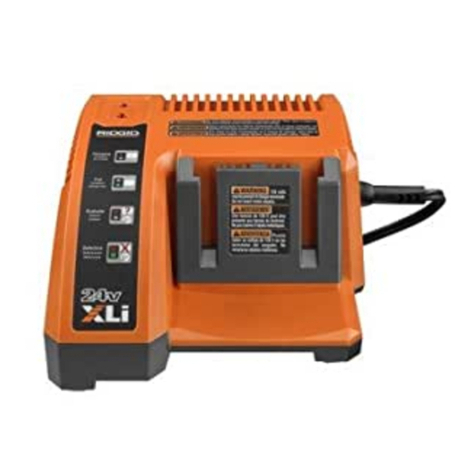
RIDGID
RIDGID R85009 User manual

RIDGID
RIDGID R840093 User manual
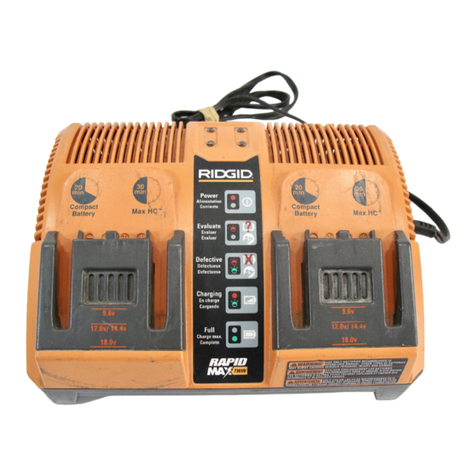
RIDGID
RIDGID 140276004 User manual
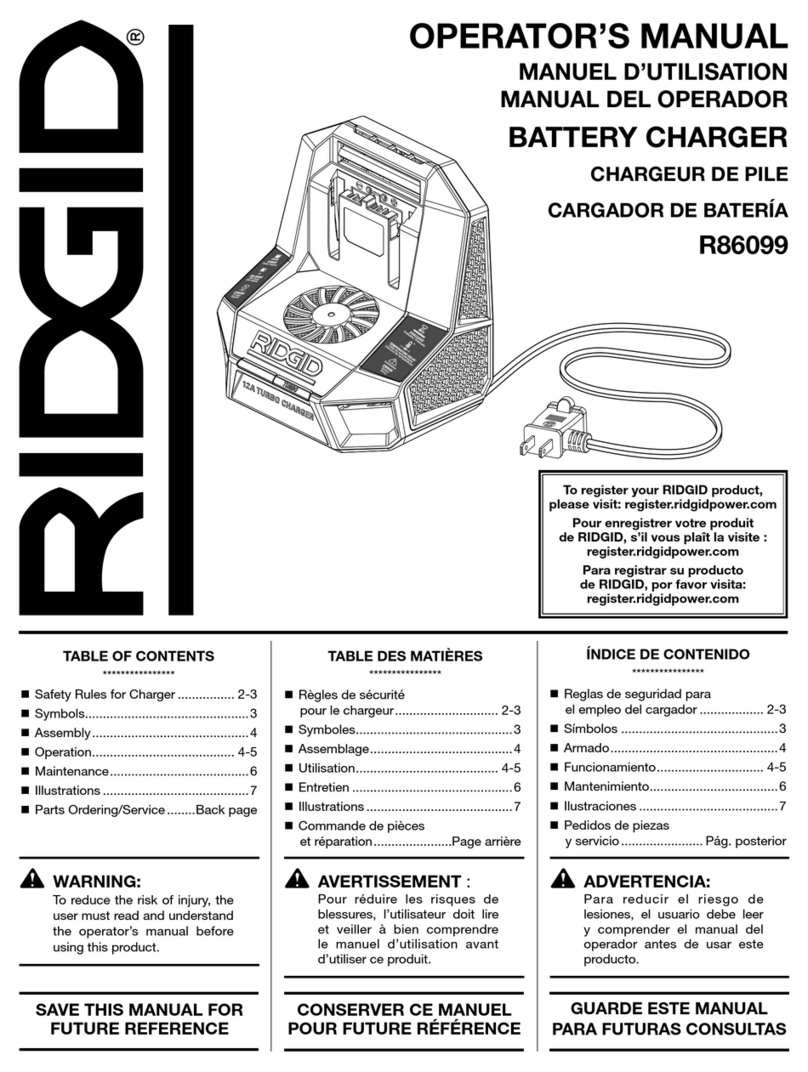
RIDGID
RIDGID R86099 User manual
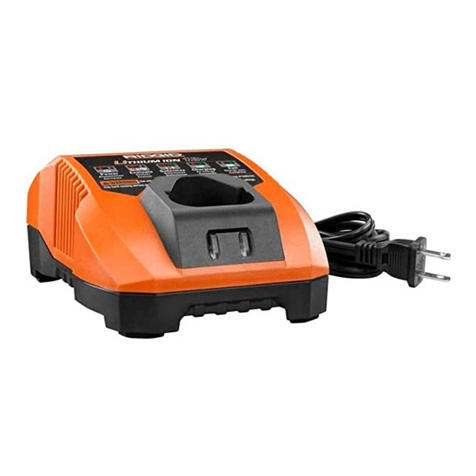
RIDGID
RIDGID R86049 User manual
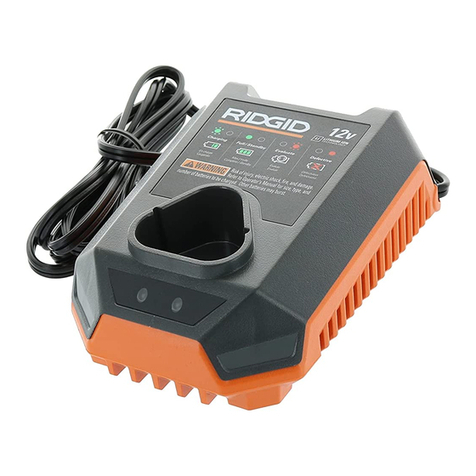
RIDGID
RIDGID R86045 User manual
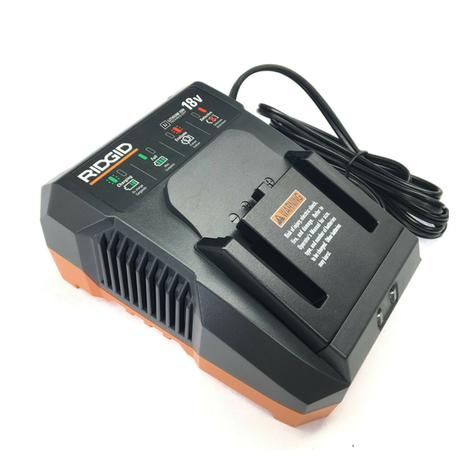
RIDGID
RIDGID R86092 User manual
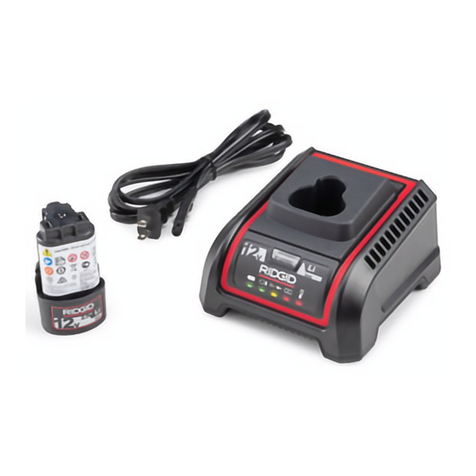
RIDGID
RIDGID RBC-121R User manual

RIDGID
RIDGID R86049 User manual
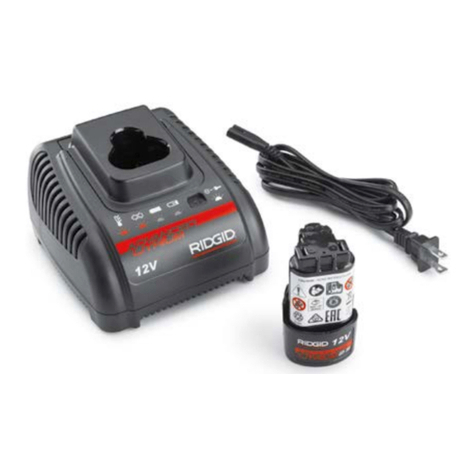
RIDGID
RIDGID RBC-121 User manual

RIDGID
RIDGID RBC-30 User manual

RIDGID
RIDGID RBC-121 User manual
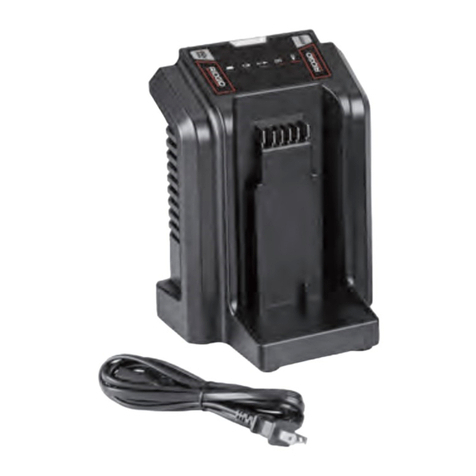
RIDGID
RIDGID RBC-FXP User manual
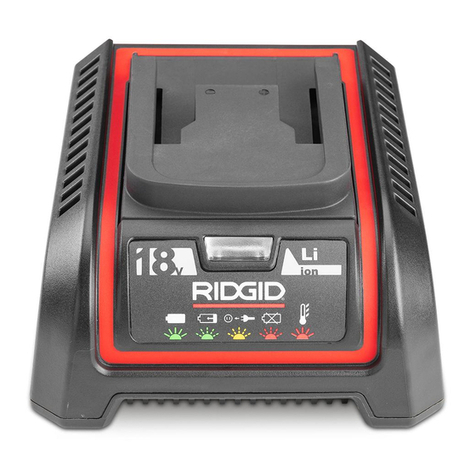
RIDGID
RIDGID RBC-30 User manual

RIDGID
RIDGID R86093 User manual
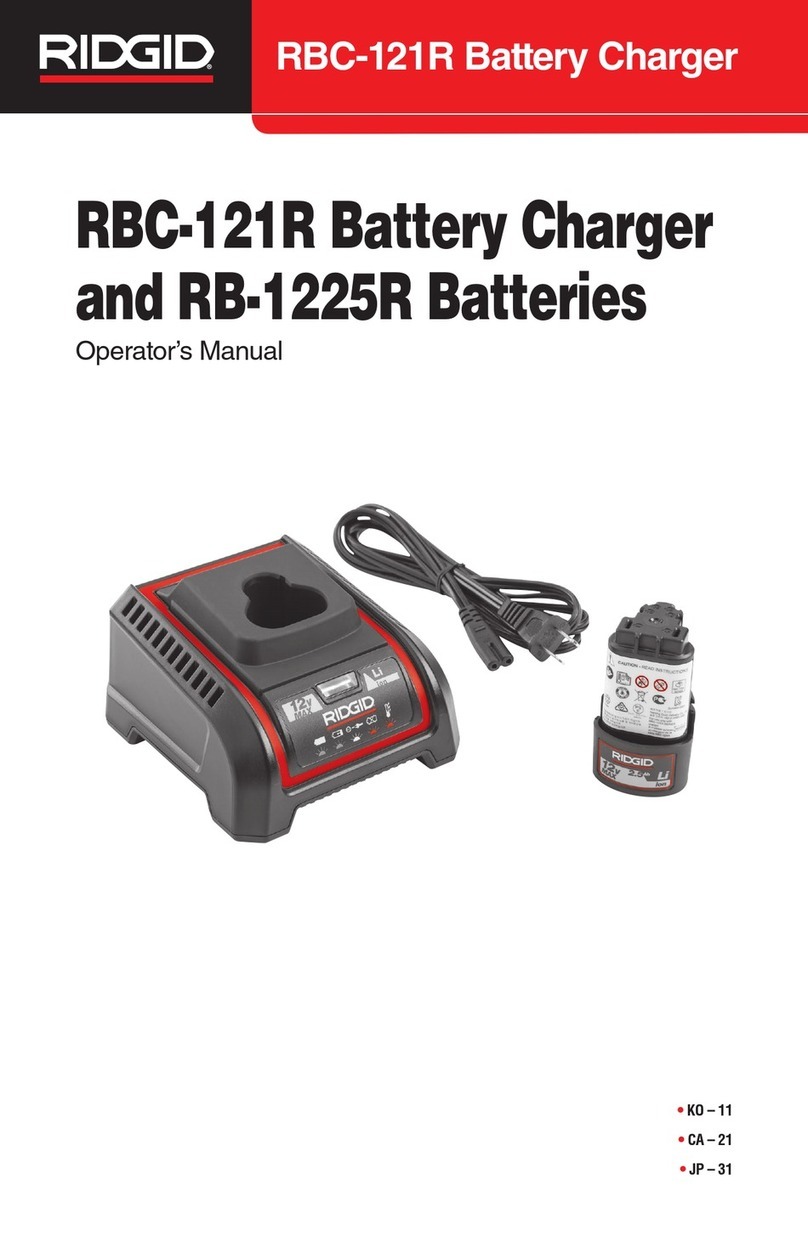
RIDGID
RIDGID RBC-121R User manual

RIDGID
RIDGID RBC-121R User manual

RIDGID
RIDGID R840095 User manual

RIDGID
RIDGID RBC-121 User manual
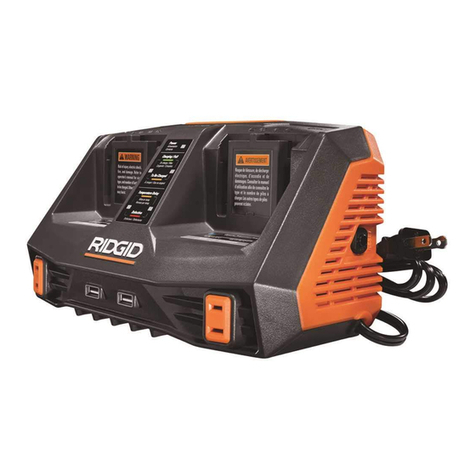
RIDGID
RIDGID R840094 User manual
